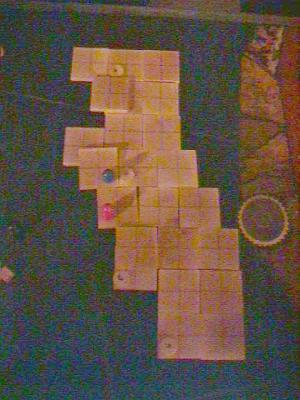![[Home]](https://ludism.org/logo/sclogo160.png)
San Andreas
James Kyle
3-4 players
45 minutes
Requires one piecepack and a few pencils or chopsticks

California after a few good quakes. Apparently, this aerial photo was found in the wreckage.
In Seattle Cosmic's unending quest to playtest all known piecepack games, at SeattleCosmicGameNight20030412, we took on San Andreas by James Kyle, the inventor of the piecepack. This game received a sort of honourable mention from judge Mike Schoessow in the Changing Landscapes game design contest:
The rules are very simple, taking about a page if you don't count the large illustration of the board. Tiles are placed on the table in the shape of the state of California. Players then take turns placing either a coin of their colour face down anywhere on the board (this represents a city), or one of the four pawns onto a coastal tile (this represents an earthquake epicenter). Once all four epicenters have been placed, an earthquake occurs. The four piecepack dice are rolled, and the tiles with the corresponding pawns shift in a way indicated in a special table. (On a null roll, the tile does not move. Whew.)
Any tile that changes its angle (flat to leaning, leaning to flat, more leaning to less, or less to more), has all of its cities destroyed. Also, if a tile overlaps the cities on another tile, those cities are destroyed as well. As each tile shifts, its epicenter is removed for the next round. The game ends after one player has placed all of their coins. Then, when all four epicenters are replaced, one last quake occurs and players' final scores are totaled (along with Los Angeles).
You might ask why anyone would place a coin on a coastal tile, since those are the tiles most likely to shift, but one's score for a city is the value of the coin minus its distance from the coast (minimum result 0). That means, for most purposes, you're just throwing away a coin with a value of 1 or 2 if you don't place it on the coast; since each tile is a 2x2 square, all inland spaces are at least two spaces away from the coast as things are reckoned. It's just so much prettier in those seaside communities... That's most of it. Pretty twisted, but what do you expect from the mind that brought us HellRail?? :)
For much of our game, players were fairly frustrated. The table we were playing on was made of some kind of fossil rock, and was very slippery, adding an unintentional dexterity element to the game. As for the intentional dexterity element ("If a tile leans too steeply to hold a coin, no city may be founded on it"), we mostly deplored it. AlphaTim suggested the game would be better played with a thin paper piecepack. A nice vinyl card table would have been at least as useful. Take heed, o ye future players of the game.
Ironically, Chris_Bender?, a new player who had never seen a piecepack before, walked away with the game. I would have come a lot closer, but suddenly a tile shifted north, and what was previously prime oceanfront property became prime lakefront property, costing me four points. For once, strategist Mark_Purtill? was at a loss in analysing a new game before play started, although afterwards he had some insightful comments. He said Chris's strategy in getting all his coins out as soon as possible was a good one (Chris was the only player to place all of his coins, I believe). If your opponents are busy placing epicenters to foil your plans, they are not themselves scoring.
The game was fairly quick (35 minutes), but I disagree with Mike Schoessow that it's just a filler. I think there are some interesting strategies to be worked out here, even though the randomness of the earthquakes adds some chaos to the game. As I mentioned, if it were not for the unexpected landlock of the water in front of my 5-point city, I coulda been a contender, coming within one point of tying, and I credit that to hanging out in the first round, and not placing any cities until I had, er, the lay of the land.
--Ron_Hale-Evans?
James Kyle responds:
From: "James K Droscha" <jdroscha@a...>
Date: Mon Apr 21, 2003 7:22 am
Subject: [piecepack] Re: [SR] Seattle Cosmic Game Night, 12 April 2003 (piecepack interest)
Hey, thanks for trying out San Andreas. Regarding the slipping of tiles... I had not considered this problem until well after the rules had been written, and it must be very frustrating (as you indicate in your session report). The piecepack we still play with at the Roundhouse is the first one I built that matches the published specifications (so you could call it the final piecepack prototype). It is fairly similar to a Mesomorph set with one significant difference... it does not have Karol's lovingly applied layers of varnish. Thus, the tectonic slippage was deceptively insignificant throughout the San Andreas playtesting.
An amusing side note: San Andreas was originally concieved as a dexterity game. The 24th tile, which is not used in the current ruleset, was flicked by players toward the map of California in an attempt to knock rival cities into the ocean. It was nuts.
Cheers, James
Rules for San Andreas at piecepack.org